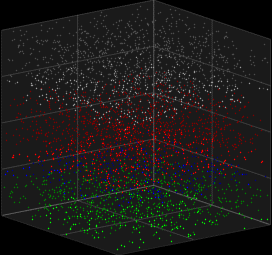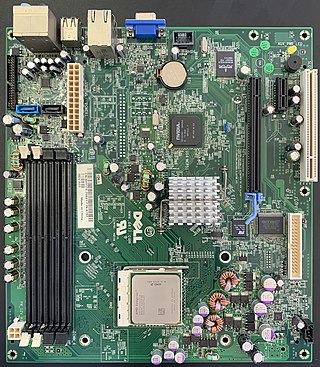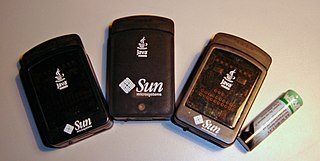
Computing is any goal-oriented activity requiring, benefiting from, or creating computing machinery. It includes the study and experimentation of algorithmic processes, and the development of both hardware and software. Computing has scientific, engineering, mathematical, technological, and social aspects. Major computing disciplines include computer engineering, computer science, cybersecurity, data science, information systems, information technology, and software engineering.

Software consists of computer programs that instruct the execution of a computer.

A programmable logic controller (PLC) or programmable controller is an industrial computer that has been ruggedized and adapted for the control of manufacturing processes, such as assembly lines, machines, robotic devices, or any activity that requires high reliability, ease of programming, and process fault diagnosis.

An embedded system is a computer system—a combination of a computer processor, computer memory, and input/output peripheral devices—that has a dedicated function within a larger mechanical or electronic system. It is embedded as part of a complete device often including electrical or electronic hardware and mechanical parts. Because an embedded system typically controls physical operations of the machine that it is embedded within, it often has real-time computing constraints. Embedded systems control many devices in common use. In 2009, it was estimated that ninety-eight percent of all microprocessors manufactured were used in embedded systems.

Computer engineering is a branch of computer science and electronic engineering that integrates several fields of computer science and electronic engineering required to develop computer hardware and software. Computer engineering is referred to as computer science and engineering at some universities.

An Embedded Operating System (EOS) is an operating system designed specifically for embedded computer systems. These systems aim to enhance functionality and reliability to perform dedicated tasks. When the multitasking method employed allows for timely task execution, such an OS may qualify as a real-time operating system (RTOS).
The Network Computer was a diskless desktop computer device made by Oracle Corporation from about 1996 to 2000. The devices were designed and manufactured by an alliance, which included Sun Microsystems, IBM, and others. The devices were designed with minimum specifications, based on the Network Computer Reference Profile. The brand was also employed as a marketing term to try to popularize this design of computer within enterprise and among consumers.

The open-design movement involves the development of physical products, machines and systems through use of publicly shared design information. This includes the making of both free and open-source software (FOSS) as well as open-source hardware. The process is generally facilitated by the Internet and often performed without monetary compensation. The goals and philosophy of the movement are identical to that of the open-source movement, but are implemented for the development of physical products rather than software. Open design is a form of co-creation, where the final product is designed by the users, rather than an external stakeholder such as a private company.
Commons-based peer production (CBPP) is a term coined by Harvard Law School professor Yochai Benkler. It describes a model of socio-economic production in which large numbers of people work cooperatively; usually over the Internet. Commons-based projects generally have less rigid hierarchical structures than those under more traditional business models.
Caldera OpenLinux (COL) is a defunct Linux distribution. Caldera originally introduced it in 1997 based on the German LST Power Linux distribution, and then taken over and further developed by Caldera Systems since 1998. A successor to the Caldera Network Desktop put together by Caldera since 1995, OpenLinux was an early "business-oriented distribution" and foreshadowed the direction of developments that came to most other distributions and the Linux community generally.

Sun SPOT was a sensor node for a wireless sensor network developed by Sun Microsystems announced in 2007. The device used the IEEE 802.15.4 standard for its networking, and unlike other available sensor nodes, used the Squawk Java virtual machine.

A computer appliance is a computer system with a combination of hardware, software, or firmware that is specifically designed to provide a particular computing resource. Such devices became known as appliances because of the similarity in role or management to a home appliance, which are generally closed and sealed, and are not serviceable by the user or owner. The hardware and software are delivered as an integrated product and may even be pre-configured before delivery to a customer, to provide a turn-key solution for a particular application. Unlike general purpose computers, appliances are generally not designed to allow the customers to change the software and the underlying operating system, or to flexibly reconfigure the hardware.

Daintree Networks, Inc. was a building automation company that provided wireless control systems for commercial and industrial buildings. Founded in 2003, Daintree was headquartered in Los Altos, California, with an R&D lab in Melbourne, Australia.

In computing, an emulator is hardware or software that enables one computer system to behave like another computer system. An emulator typically enables the host system to run software or use peripheral devices designed for the guest system. Emulation refers to the ability of a computer program in an electronic device to emulate another program or device.

Open-source robotics is a branch of robotics where robots are developed with open-source hardware and free and open-source software, publicly sharing blueprints, schematics, and source code. It is thus closely related to the open design movement, the maker movement and open science.
Open manufacturing, also known as open production, maker mamanufacturing or material peer production and with the slogan "Design Global, Manufacture Local" is a new model of socioeconomic production in which physical objects are produced in an open, collaborative and distributed manner and based on open design and open source principles.
Equihash is a memory-hard Proof-of-work algorithm introduced by the University of Luxembourg's Interdisciplinary Centre for Security, Reliability and Trust (SnT) at the 2016 Network and Distributed System Security Symposium. The algorithm is based on a generalization of the Birthday problem which finds colliding hash values. It has severe time-space trade-offs but concedes vulnerability to unforeseen parallel optimizations. It was designed such that parallel implementations are bottle-necked by memory bandwidth in an attempt to worsen the cost-performance trade-offs of designing custom ASIC implementations. ASIC resistance in Equihash is based on the assumption that commercially-sold hardware already has quite high memory bandwidth, so improvements made by custom hardware may not be worth the development cost.

Open source is source code that is made freely available for possible modification and redistribution. Products include permission to use the source code, design documents, or content of the product. The open-source model is a decentralized software development model that encourages open collaboration. A main principle of open-source software development is peer production, with products such as source code, blueprints, and documentation freely available to the public. The open-source movement in software began as a response to the limitations of proprietary code. The model is used for projects such as in open-source appropriate technology, and open-source drug discovery.
An Open Value Network (OVN) is a new organizational framework designed to support commons-based peer production. Inspired by the value network concept introduced by Verna Allee. This organization is by nature and from birth transnational.











